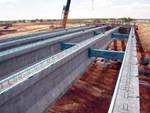Structural makeover: Big bridge-strengthening project
The 2.5-km/1.6-mile long cable-stayed-concrete West Gate Bridge in Melbourne, Australia, is prepped for added traffic lanes with BASF's MBrace composite reinforcements, pultruded by EPSILON Composite (Gaillan-en-Médoc, France).
In what is reportedly the largest bridge-rehabilitation project ever undertaken with composites, the 2.5-km/1.6-mile long cable-stayed-concrete West Gate Bridge, the third largest in Australia, is getting a makeover. The bridge’s central, three-cell box girder rises 58m/190 ft above the Yarra River in Melbourne, Victoria, with attached precast cantilevered frame elements that support the roadway. A tremendous increase in traffic since the bridge opened in 1978 — it now accommodates 160,000 vehicles per day — prompted the Roads Corp. of Victoria (VicRoads), the state’s highway authority, to commission a study 10 years ago to determine the best way to address the increased design loads if traffic lanes were added. The selected concept combined post-tensioned tendons in the box girder with precured carbon fiber-reinforced polymer (CFRP) laminates. Despite higher material costs, compared to a steel plate solution, this alternative promised ease of installation, lack of traffic disruption and virtually no long-term maintenance costs.
Granted $240 million (AUS) in state and federal funds, the West Gate Bridge Strengthening Alliance — VicRoads; construction firm John Holland and design/engineering firm Sinclair Knight Merz (both of Melbourne); and designer Flint and Neill Partnership (London, U.K.) — started work on the bridge’s east end in October 2009. Crews applied Melbourne-based BASF Corporation - Building Systems trademarked MBrace uni carbon laminates, pultruded by EPSILON Composite (Gaillan-en-Médoc, France), and carbon fabrics wet out with BASF epoxy around the box girder’s perimeter. To increase the deck slab’s flexural capacity between the cantilever frames, CFRP strips were inserted into slots cut into the deck. Other key areas (e.g., where the frames attach to the box girder) also were strengthened, say Rob Irwin and Amar Rahman of BBR Systems Ltd. (Zurich, Switzerland), who provided early design/technical support. More than 100 km/62 miles of carbon plates, 10,000m² (107,670 ft²) of carbon fabric, 65 metric tonnes (143,300 lb) of adhesive and 20 metric tonnes (44,100 lb) of epoxy resin will be used before the project ends in 2011. BASF business manager Andrew Sarkady says, “With the Alliance, we were able to find a smart solution, which led to significant savings, based on reduced labor alone.”
Related Content
-
Creative Composites Group introduces H-5 rated FRP bridge decking
High-strength pultruded SuperDeck Lite gives ambulances and maintenance vehicles access to trails, bridges, boardwalks and sidewalks
-
Exel Composites supplies fiberglass profiles for Foton electric buses
Partnership with Chinese automotive manufacturer will see the implementation of pultruded profiles in various bus models, backed by weight savings, complex geometries and long life.
-
Biocomposite for mobile architecture, low load-bearing applications
The German Institutes of Textile and Fiber Research and partners have developed a biocomposite well suited for support profiles and connecting nodes in construction applications.















